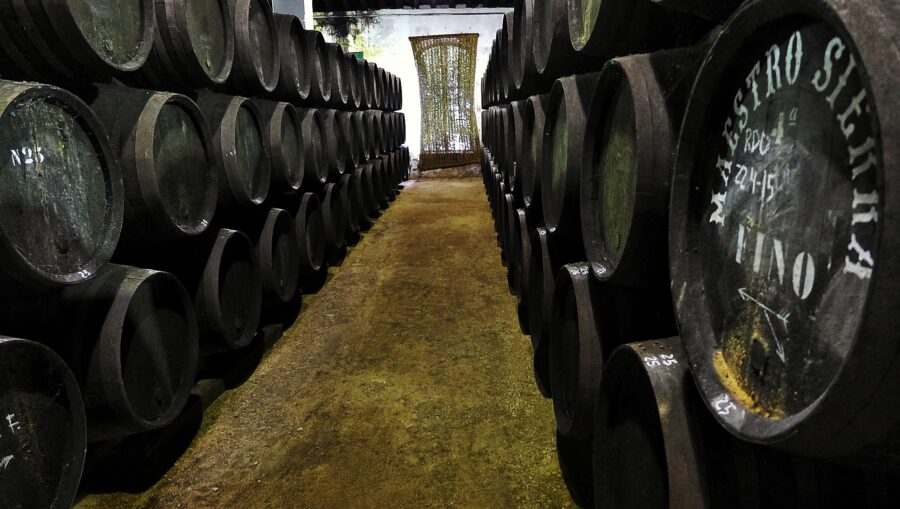
30 Apr Sherry! And now stop calling it old-fashioned or hip.
Since I started working in the hospitality industry in the mid-1990s, I think I have seen a Sherry campaign pass by at least 10 times. With a loud cry each time: it’s hip! It’s back! We’re all drinking it this summer! And more statements to this effect. But really more of a desperately expressed wish. Because, of course, it’s not that easy to get this once popular wine drunk by a new audience. But let me put it this way: it would go a lot easier if you don’t think of it as “hip” or “trendy. By Albert van Beeck Calkoen Photo credits: Albert van Beeck Calkoen (header) and Sherry Wines (rest)
What then?
Well, that’s a very good question, but fortunately also with a fairly simple answer.
You see, sherry can be drunk simply because it can be very good.
Okay, that’s pretty short, but what I want to say is that sherry is a wine that involves so much craft that it’s quite OK to learn to appreciate it.
Learning to appreciate this type of wine for how it’s made, that’s the bottom line.
And by appreciating it for its craft, you can also learn to appreciate the flavors.
On a side note, there are also Sherry’s of lesser quality.
In the article below, I give what you can recognize quality by.
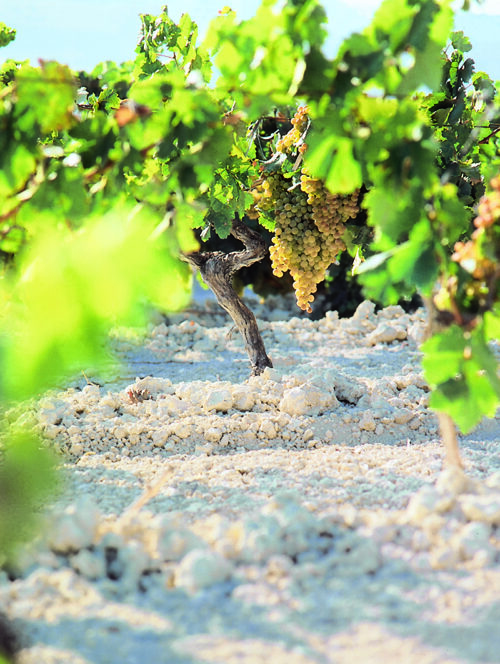
First, let’s start by calling Sherry what it is: a wine.
And since you drink wine in a wine glass, you can just do the same with Sherry.
That way, the wine gets room to breathe.
That familiar little shot glass just does Sherry a disservice.
You may have already noticed that I write Sherry with a capital letter.
That’s because we’re actually talking about Jerez-Xérès-Sherry from the Marco De Jerez region, a geographical indication.
This area consists of the triangle between the cities of Jerez de la Frontera, El Puerto de Santa María and Sanlúcar de Barrameda, supplemented by about 6 towns located nearby.
Wine has been made in this triangle for more than 3,000 years.
The name Sherry comes from the Arabic word Sherish, the former name of the city of Jerez.
Grapes and ripening
The grapes used to make Sherry are Palomino, Pedro Ximénez and Moscatel.
Well organized.
The subsoil of this area consists mainly of porous limestone.
This holds water from autumn and winter well while allowing roots to reach deep into the soil.
But actually it is better to say that Sherry is made in the bodegas and not in the vineyard.
After harvesting, these grapes are taken to the press houses or, if a sweeter variety is to be made from the grapes, spread out in the vineyard on mats to dry in the sun.
The latter process is called asoleo. The Palomino grape is used for Fino and Oloroso sherry.
The wine from the first pressing (mosto de yema) has a percentage of 12 – 13% alcohol and is inspected by the cellar master, who judges whether the wine is Palo (for Fino or Manzanila) or Gordura, and will be used for Oloroso.
In traditional bodegas, this first fermentation still takes place in 600-liter barrels of American oak.
In larger-scale bodegas, this fermentation takes place in stainless steel tanks.
After this, these wines are fortified to 15% and 17-18% alcohol respectively and become part of the special Solera system.
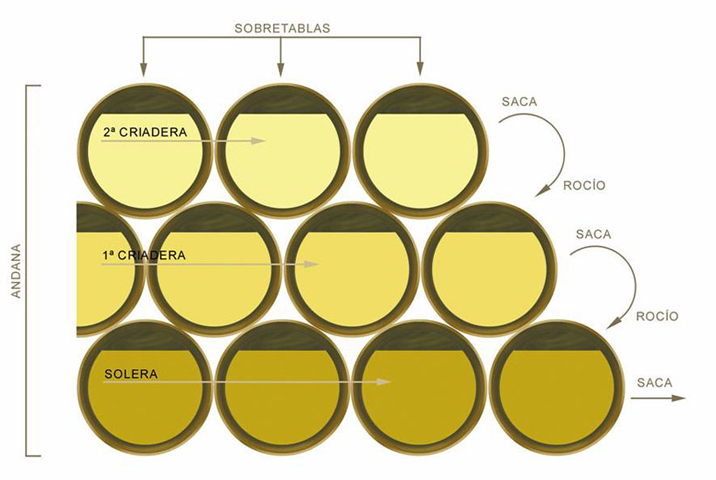
Solera = Sherry
Conceived in Sherry in the late 1700s, this Solera system works on the principle that the old wines “raise” the young.
In the Bodegas, the barrels are stacked at least 3-high, but this can go up to as many as 14 criaderas.
By the way, those layers do not all have to be stacked, the criaderas can also be in spaces next to each other.
The youngest wines are on top and below them are the older ones.
Every so often, 1/3 is removed from the barrels (the interval and quantity varies from bodega to bodega, so I cannot be more specific).
The wine from the lower barrels goes into the bottle, while the other barrels are thus mixed with younger wines. This creates a special blend of Sherry wines that in theory could still contain Sherry from the very first harvest.
For example, if a Bodega started making Sherry in 1847, in theory there could still be wine from that year in the barrel.
Solera, by the way, is derived from the Latin word solum, meaning floor.
The bottom, or last layer of barrels is therefore called the Solera.
Velo de flor
What is also special about Sherry is the way it is aged.
With Fino and Manzanilla, a layer of yeast forms on the wine, protecting it from oxidation by oxygen.
This layer is called velo de flor and creates those distinctive nutty and fruit flavors (which you have to “learn” to appreciate).
Oloroso sherry is fortified to 17-18% alcohol, which is too high for the yeast cells to survive.
So this wine does not get that yeast layer and therefore starts to react (oxidize) with the oxygen in the barrel.
As a result, Oloroso Sherry is a lot darker in color.
This type of sherry is extremely popular for making whiskey barrels.
So one could well argue that the lover of whiskies aged in ex-Sherry casks could also very well appreciate a Sherry.
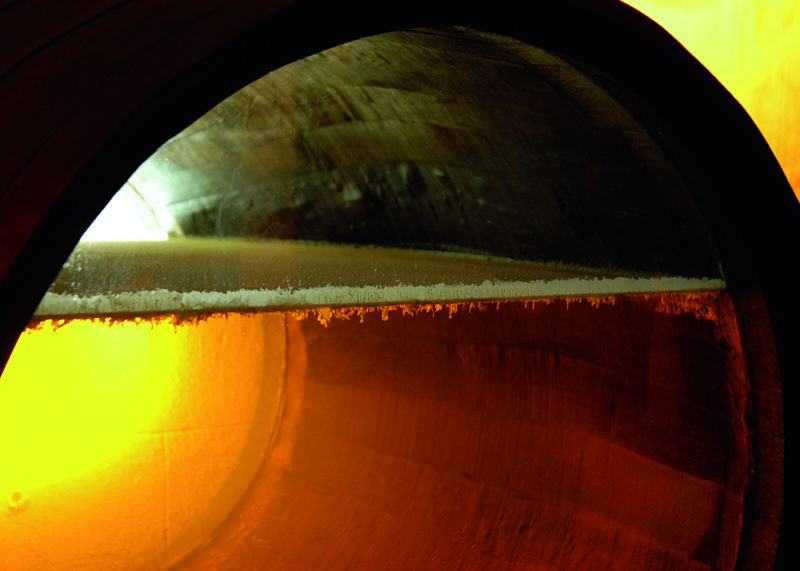
The typical yeast layer that gives Fino and Manzanilla Sherry its special flavor.
Amontillado
The Solera system is essential for the maturation process with yeast layer.
It needs oxygen and nutrition to persist.
Annual siphoning of the wines refreshes the oxygen and nutrients in the barrels.
But eventually, in old Fino sherries, this layer can die off and the wine will oxidize anyway and also slightly increase in alcohol percentage.
This changes both the color and the flavor.
In lighter Fino sherry, almond is a distinctive tone; in old Fino, this changes to hazelnut and higher alcohol content.
This is then called a Fino-Amontillado Sherry. Eventually, this Sherry can mature into Amontillado, with a percentage between 16 and 22%.
However, this is a very labor-intensive and costly process, which takes years.
Oloroso, meaning “fragrant,” is spicier, darker and has a softer texture and has a final alcohol content of 17 – 22 %.
These wines, meaning Fino, Amontillado and Oloroso are dry or generoso.
There are obviously exceptions to this, but I’m going to spare you those, as well as the extremely complex way of which is involved in making Sherry.
We’re not going to make it unnecessarily difficult here.
Manzanilla & Palo Cortado
Or yet a little hard to do, because there is also Manzanilla.
That can only be made in the coastal town of Sanlúcar de Barrameda.
The atmospheric conditions are different here than in the higher elevations, so the flor develops differently.
This yeast layer is a lot thicker here, so the flavor is different from the Fino.
By the way, there is also the Palo Cortado, a Sherry praised among connoisseurs, which is midway between an Oloroso (texture and body) and Amontillado (nose).
And while we’re at it, the Cream Sherry is a blend of Oloroso and PX(Pedro Ximénez), a dark brown wine with ditto flavors.
This PX, by the way, is very sweet due to sun drying and only partial fermentation, with a sugar content of 150 g – 500 g/ltr.
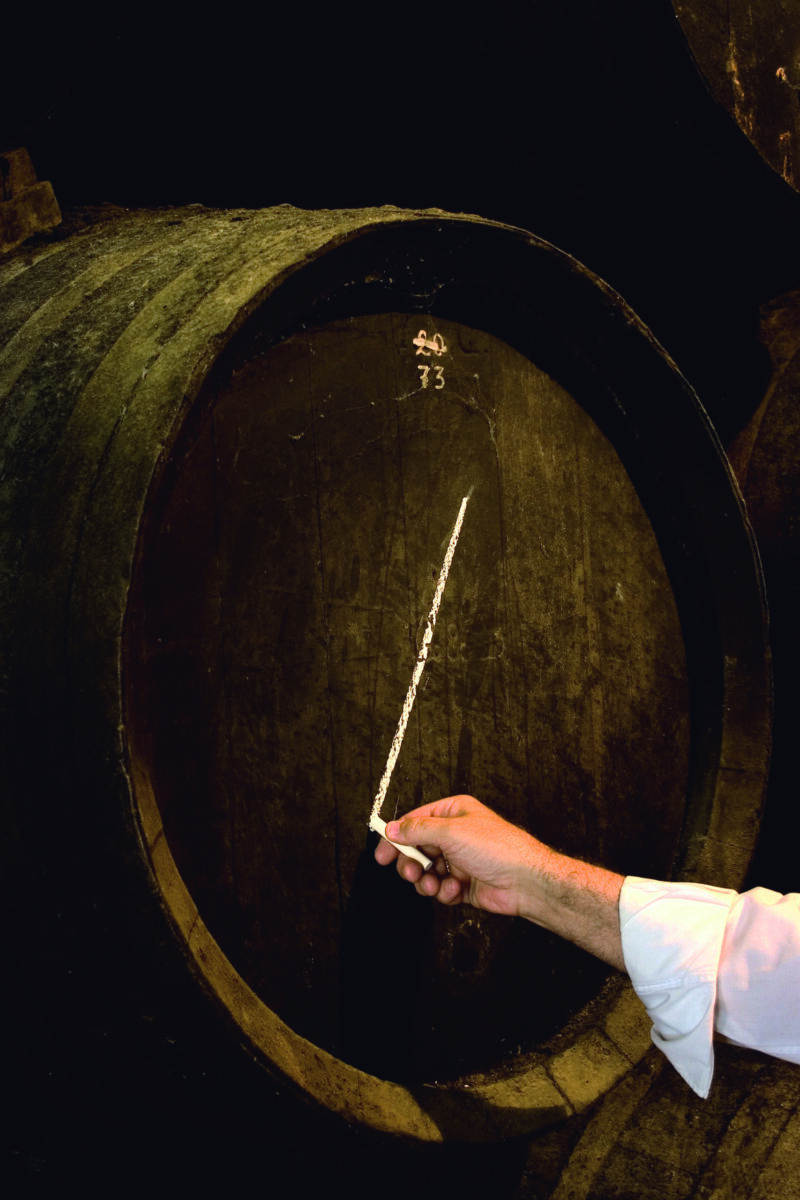
This stripe is the sign the cellar master gives to Fino Sherry.
An “O” indicates Oloroso.
How do you store Sherry?
We cannot avoid naming some stereotypical prejudices of Sherry.
The bad image most have of this wine (not to mention the stereotypical drinker) comes from how Sherry is stored.
This goes (very) often wrong.
Sherry is a wine and that is how you should store it: cold and dark.
Even the unopened bottle has a limited shelf life, although how long varies by variety.
It may very well be that your first encounter with Sherry was one of that dusty half-empty bottle in the back of your grandmother’s liquor cabinet.
Also useful to know: Sherry is not meant to be stored for a long time.
The most optimal time or drinking it is when it is bottled; after that, it does not age through.
In fact, after a while the quality really deteriorates.
The Sherry Wines website has a good description of how best to store which kind of Sherry.
But we have already filtered out the most important points.
Shelf life of Sherry
Shelf life differs between the oxidatively aged Oloroso and the yeast-aged Fino or Manzanilla.
Closed bottles of Sherry store upright in a cool place.
Once the bottles are opened, the counter starts running.
Fino and Manzanilla are kept in the refrigerator; other Sherry can be kept outside.
This, in turn, has to do with the method of aging. Tip: when buying a bottle, always check what the bottling date was.
That way you know how “fresh” your Sherry is and how long you can keep it unopened, if necessary.
But it’s better to open a bottle of Sherry as soon as you buy it.
It might also be helpful to buy half a bottle first if you’re going to venture into Sherry. Fino and Manzanilla can be kept unopened for a year and after opening (cooled) for 1 week. Oloroso you can keep up to 3 years unopened and drink within 2 months after opening. Amontillado and Cream are in between, but because of the more exclusive character of Amontillado in particular, it is simply better not to keep them open too long.
Keep in mind 2 years unopened and 1 month opened. Pedro Ximénez again can be kept a bit longer, 2 to 4 years, and good for up to 2 months after opening. This article was produced in collaboration with Pitch PR on behalf of the Consejo Regulador de las Denominaciones de Origen “Jerez-Xérès-Sherry” and “Manzanilla-Sunlúcar de Barrameda,” with assistance from the European Union.




No Comments